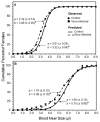La Crosse virus infection alters blood feeding behavior in Aedes triseriatus and Aedes albopictus (Diptera: Culicidae)
- PMID: 23270172
- PMCID: PMC3551617
- DOI: 10.1603/me12023
La Crosse virus infection alters blood feeding behavior in Aedes triseriatus and Aedes albopictus (Diptera: Culicidae)
Abstract
The effects of La Crosse virus (LACV) infection on blood feeding behavior in Aedes triseriatus (Say) and Aedes albopictus (Skuse) were investigated in the laboratory by measuring the size of the bloodmeal imbibed and the extent of refeeding by virus-infected and uninfected mosquitoes. LACV-infected Ae. triseriatus and Ae. albopictus took significantly less blood compared with uninfected mosquitoes. Twice as many virus-infected Ae. triseriatus mosquitoes refed compared with uninfected individuals (18 vs. 9%; P < 0.05); however, virus infection had no significant effect on the refeeding rate of Ae. albopictus. Reduction in bloodmeal size followed by an increased avidity for refeeding may lead to enhanced horizontal transmission of the LACV by its principal vector, Ae. triseriatus.
Figures

References
-
- Barker CM, Paulson SL, Cantrell S, Davis BS. Habitat preferences and phenology of Ochlerotatus triseriatus and Aedes albopictus (Diptera: Culicidae) in Southwestern Virginia. J Med Entomol. 2003;40:403–410. - PubMed
-
- Beaty BJ, Thompson WH. Delineation of La Crosse virus in developmental stages of transovarially infected Aedes triseriatus. Am J Trop Med Hyg. 1976;25:505–512. - PubMed
-
- Black WC, IV, Moore CG. Population biology as a tool to study vector-borne diseases. In: Marquardt WC, editor. Biology of Disease Vectors. Elsevier Academic; London, United Kingdom: 2005. pp. 187–206.
-
- Briegel H, Lea AO, Klowden MJ. Hemoglobinometry as a method for measuring blood meal sizes of mosquitoes (Diptera: Culicidae) J Med Entomol. 1979;15:235–238. - PubMed
-
- Brown D, Rothery P. Models in biology: mathematics, statistics, and computation. Wiley; West Sussex, England, United Kingdom: 1993.
Publication types
MeSH terms
Grants and funding
LinkOut - more resources
Full Text Sources

